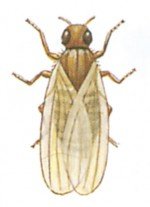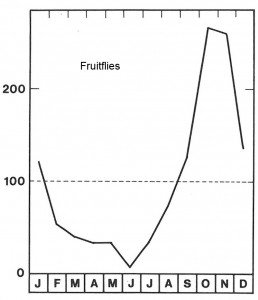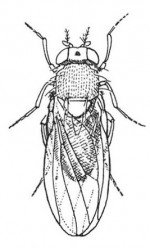Latin: Drosophila spp. Also called vinegar flies.


Fruit flies are quite rich on species. We know more than 6000 different species, but only a few of them are found indoors. Adult fruit flies are 3-4 mm long, yellowish brown. They typically fly quietly. The larvae are yellowish-white maggots. Pupae almost look like small brown seeds. Adult fruit flies are attracted to the smell of fermenting fruit and vegetables. It is the smell of the various alcohols, formed during the fermentation that they are attracted to. They also like wine, beer, vinegar, milk, ketchup and jam. The females lay their small whitish eggs, which are barely visible, in these foods. Each female lays about 25 eggs per day and up to 1000 in total. The eggs hatch after one day and the small larvae seek into the food. At room temperature, the larvae leave the food and pupate after 4-5 days. In the pupa transformation to adult fruit flies lasts 3 – 4 days. Fruit flies can begin to lay eggs as early as 24 hours after leaving the pupal stage. Under favourable circumstances, at 25-30 ° C the lifecycle is completed within just 10 days.

During the summer fruit flies breed in the wild, so one has to be aware of trash cans and compost piles that can act as hotbeds. If fruit flies are a problem for businesses and residential buildings near you, the solution is to dust surfaces of the larval development sites with insect powder. In companies that can and pickle vegetables and fruit must try to effectively block the flies out. In addition, make sure to keep the food, in which flies like to lay eggs, so they cannot get to them. It is easy to overlook how little space fruit flies need to develop. Returnable packaging in the form of barrels, jars and bottles holding slops can cause large fly populations and the same goes for poorly cleaned waste containers. The fruit fly pupae, which almost are cemented to surfaces, are difficult to remove and may give rise to complaints in connection with recyclable packaging. Adult fruit flies are sensitive to the common fly sprays with pyrethrin.




